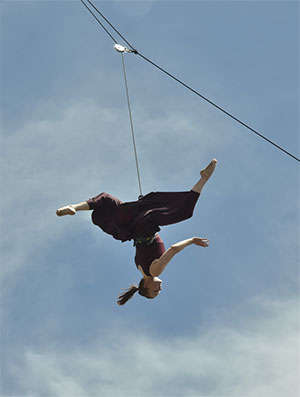UW Faculty Members’ Continued Research Finds Vertical Dancers Have Keen Eye for Inverted Motions
Published January 29, 2025

Vertical dancers -- those who dance high in the air many feet off the ground -- may not be able to spin a web or effortlessly scale a wall like Spiderman. But it could be argued that they do possess their own brand of superpower: the ability to discern inverted motions better than most.
“By virtue of eye-tracking technology, we provided empirical evidence to account for the superior ability only demonstrated by the experienced vertical dancers in discerning the inverted motions,” says Qin Zhu, a professor and interim director of UW’s Division of Kinesiology and Health. “This advantage appears to be linked to a distinct gaze behavior. That is, vertical dancers exhibit selective attention towards the pelvic region of the dancer, allowing them to extract relevant spatiotemporal cues for identifying the type and intention of the movement. We hypothesize that this unique gaze pattern is cultivated through extensive exposure to, and practice with, inverted movements.”
Zhu was senior author of a paper, titled “Experience Modulates Gaze Behavior and the Effectiveness of Information Pickup to Overcome the Inversion Effect in Biological Motion Perception,” that was published Jan. 28 in PLOS ONE. The journal accepts research in over 200 subject areas across science, engineering, medicine, and the related social sciences and humanities.
Xiaoye Michael Wang, a research associate in the Faculty of Kinesiology and Physical Education at the University of Toronto, was the paper’s co-lead and corresponding author.
The study compared the gaze of non-dancers, typical dancers and vertical dancers when observing a computer point-light display of upright and inverted dance movements -- either on the ground or in the air -- to determine whether the point-light displays were artificially inverted, according to the paper.
Point-light displays represent a person or an animal using a series of moving points placed at different major body joints, including shoulders, elbows, wrists, the pelvis, knees and ankles.
The study showed that vertical dancers were more sensitive in detecting inverted movements, and eye-tracking data revealed that vertical dancers have longer fixations, which is primarily directed at the depicted dancer’s pelvic region.
“This outcome was not originally hypothesized, but suggested by our results and our interpretation,” Zhu says. “Pelvic motion contains unique information regarding a constraint that can only be experienced by vertical dancers. That is, they must overcome the pendulum swing to perform the dance movement in the air because they must wear a harness at the hips that is attached to a rope extended from an anchor at the ceiling.”
For the study, a professional female and male dancer were each fitted with 13 optical markers that corresponded to 13 major joints. The optical markers’ 3D positions were captured using a motion capture system. Each dancer performed 20 movements, where 10 movements were performed on the ground and the other 10 movements were performed in the air while being suspended with a harness.
The study was composed of 37 adult volunteers -- 12 participants without any dance experience; 13 typical dancers with an average of 12.25 years of dance experience; and a dozen vertical dancers with an average of 9.82 years of vertical dance experience.
Other researchers who contributed to the paper are Zhichen Feng, a second-year UW master’s student specializing in motor control in the Division of Kinesiology and Health; Mingming Yang, a second-year doctoral student in UW’s Biomedical Science Program; Margaret Wilson, a professor emeritus of dance and previous chair of UW’s Department of Theatre and Dance, as well as a vertical dancer; and Jing Samantha Pan, a professor in the Department of Psychology at Sun Yat-sen University in Guangzhou, China. Wilson was the paper’s collaborating author.
This study was a follow-up to research published in Scientific Reports in fall 2022. That research showed that the inversion effect in perceiving biological motion can be overcome by persons -- such as vertical dancers -- with extended visuomotor experience with inverted movements.

